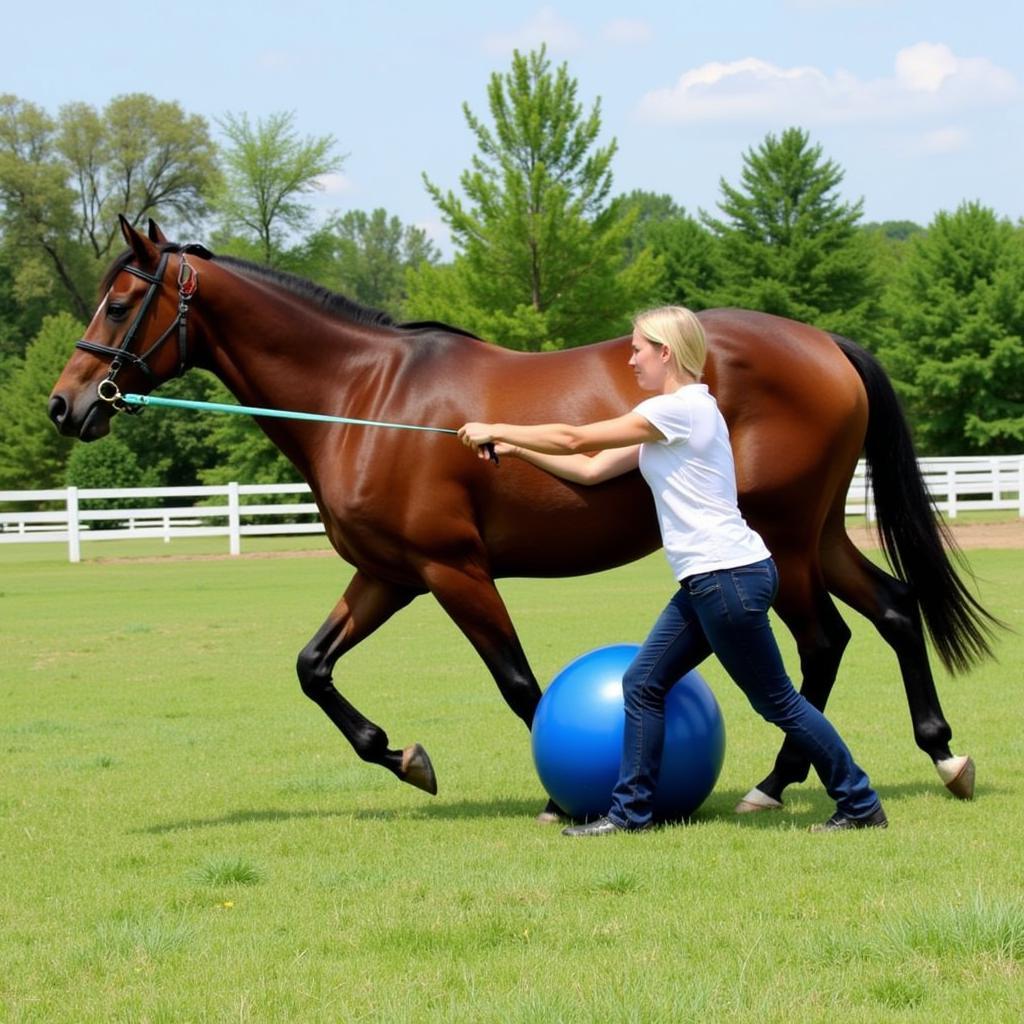Horse Exercise Balls are becoming increasingly popular tools for equine fitness and rehabilitation. They provide a unique way to engage a horse’s core muscles, improve balance, and enhance coordination. This comprehensive guide will delve into the benefits, uses, and safety considerations surrounding horse exercise balls.
Are horse exercise balls right for every horse? While they offer numerous benefits, it’s important to understand how they work and when they’re appropriate. We’ll explore the different types of exercise balls, how to introduce them to your horse, and how to incorporate them into a balanced training program. From improving posture to aiding in recovery, horse exercise balls can be a valuable asset for horse owners dedicated to their animal’s well-being. Learn more about desensitizing your horse to new objects.
The Benefits of Using a Horse Exercise Ball
Horse exercise balls offer a dynamic approach to equine fitness. By encouraging subtle shifts in weight and posture, they activate core muscles that are often underutilized in traditional training. This core engagement is crucial for stability, balance, and overall athletic performance. Additionally, exercise balls can improve proprioception, which is a horse’s awareness of its body in space. This heightened awareness translates to better coordination and agility.
For horses recovering from injuries, exercise balls can be a valuable tool in rehabilitation. They allow for controlled, low-impact movements that help rebuild muscle strength and range of motion. This gentle form of exercise can also aid in reducing inflammation and promoting healing.
Introducing Your Horse to the Exercise Ball
Introducing a horse exercise ball should be a gradual and positive process. Start by allowing your horse to investigate the ball visually and through smell. You can then gently touch the ball to your horse’s legs and body, helping them become accustomed to its texture and movement. Once your horse is comfortable with the ball’s presence, you can begin introducing it into their training routine.
It’s essential to work with a qualified equine professional when introducing an exercise ball. They can assess your horse’s individual needs and guide you through the proper techniques. This ensures the safety and well-being of your horse while maximizing the benefits of the exercise ball. If you’re looking to expand your horse’s toy collection, consider a horse ball toy.
Incorporating the Exercise Ball into Training
Horse exercise balls can be incorporated into various training regimens. They can be used for in-hand exercises, lunging, or even ridden work. The specific exercises and duration will depend on your horse’s fitness level, age, and any existing health conditions. It’s crucial to start slowly and gradually increase the difficulty and duration of the exercises as your horse progresses. You can find horse trailers for sale in New York State if you are looking for transportation options.
 Horse Exercise Ball: Lunging Session
Horse Exercise Ball: Lunging Session
One of the key advantages of exercise balls is their versatility. They can be used to target specific muscle groups, improve balance and coordination, and even address behavioral issues like anxiety or fearfulness. Learn more about how to handle a scared horse. For horses participating in demanding sports like water horse football, exercise balls can provide valuable cross-training benefits.
Types of Horse Exercise Balls
Several types of exercise balls are available, each designed with specific features and benefits. Some balls are filled with air, while others are made of dense, durable materials like rubber. The size and firmness of the ball should be chosen based on your horse’s size and the intended use.
Are Horse Exercise Balls Safe?
When used correctly and under the guidance of a qualified professional, horse exercise balls are generally safe. However, it’s crucial to follow proper safety protocols to prevent injuries. Ensure the ball is appropriately inflated and free from any damage. Always use a well-fitted halter and lead rope, and never leave your horse unattended with the ball.
Conclusion
The horse exercise ball is a versatile tool that can significantly enhance equine fitness and rehabilitation. By understanding the benefits, uses, and safety considerations, horse owners can effectively incorporate this innovative tool into their training programs, promoting their horse’s overall well-being. Remember to consult with an equine professional for personalized guidance and ensure a safe and effective training experience with the horse exercise ball.
FAQ
- How often should I use an exercise ball with my horse?
- What size exercise ball is appropriate for my horse?
- Can I use an exercise ball with a young horse?
- Are there any specific exercises I should avoid with the ball?
- What are the signs that my horse is uncomfortable with the ball?
- How do I clean and store a horse exercise ball?
- Can I use a human exercise ball for my horse?
Possible Scenarios & Questions
-
Scenario: Horse is hesitant to approach the ball.
- Question: How can I desensitize my horse to the exercise ball?
-
Scenario: Horse loses balance on the ball.
- Question: What are some exercises to improve my horse’s balance on the ball?
-
Scenario: Horse seems to be experiencing discomfort during exercise.
- Question: Should I stop using the ball and consult a veterinarian?
Further Reading
You might also be interested in our articles on scared horse and horse ball toy. For those interested in equine sports, we also have an article on water horse football.
Contact Us
For further assistance with equine care and training, please contact us. Call us at 0772127271, email [email protected], or visit our facility at QGM2+WX2, Vị Trung, Vị Thuỷ, Hậu Giang, Việt Nam. Our customer service team is available 24/7.